October 27, 2016
With the top trend for data center and enterprises to move to higher data rate like 40G, relevant products and technologies are developed to back this new speed (e.g. the 40G optical transceivers and cables). However, there are so many options out there on the market. Network users usually don’t know how to make a choice. Take the 40G cables as an example, the most commonly used 40G cables are the 40G direct attached cable (DAC) and active optical cable (AOC). Each has its unique specification and usage. Which would be the most suitable one for connecting signals across the rack in data center? This article will provide you an ideal answer from the aspect of cabling performance, transmission distance and cost.
Brief Overview of DAC and AOC Cables
QSFP DAC cable is a form of high-speed cable with "transceivers†on either end used to connect 40Gbqs switches to routers or servers. QSFP+ DAC cable usually comes in either active or passive versions. They are widely available for short-reach 40G interconnect (within 7 meter). 40G DAC cables transmit 40GbE over short distances of parallel coaxial copper cabling. It uses a special cabling assembly with four lanes of coaxial cabling. Each transmit 10 Gbps for a total data rate of 40 Gbps. QSFP to QSFP and QSFP to SFP+ cable are the two common types of 40G DAC cables. The picture below shows a QSFP to SFP+ DAC breakout cable connected in a switch.
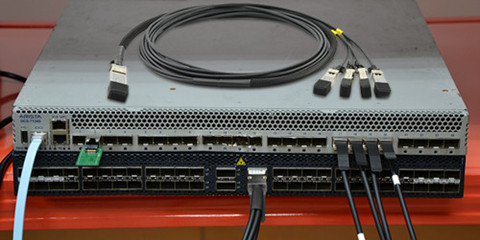
AOC cable uses electrical-to-optical conversion on the cable ends to improve speed and distance performance of the cable while mating with electrical interface standard. Compared with DAC cables, its smaller size, longer transmission distance, lower insertion loss and electromagnetic interference immunity make it popular among subscribers. 40G AOC cables (see in the image below) can support longer distance than QSFP+ DAC cables (within 15m).
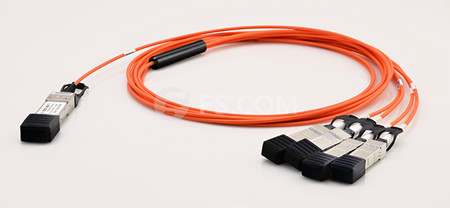
Comparison Between DAC and AOC Cables
After the brief introduction to the DAC and AOC cables, what to be considered next is the detailed comparison from the expects of cost, distance and cabling performance. The following chart shows a vivid comparison between them.

Cost
Cost is typically the No.1 factor affecting your selection. When it comes to 40G DAC cables, it is the same, although it’s quite clear that copper is much cheaper than optical cable. AOC, with connectors embedded with electronics and/or optics is the most expensive one. But it supports the highest transmission distance, many data centers won’t choose it because of the high cost.
While passive copper cable is much cheaper than AOC. However, the truth is that it cannot support 40G transmission in most cases in data center. Active copper cable is less expensive than AOC and can support longer transmission than passive copper cable seems to be a good choice. In this battle over cost, passive copper cable wins. But it is not suggested for 40G transmission in most cases.
Power Consumption
The main reason why DAC active copper cable and AOC can support longer transmission distance than passive cooper cable is that they are supported with active electronics. Passive copper cable requires no power. For 40G transmission, the power required for active copper cable is about 440mW, which is much less than that of AOC—2W. Thus, passive copper cable wins for its low power consumption.
Cooling System
Cooling is always crucial for data center, as it is closely related to the data center reliability and life of use. During DAC cable selection, two main factors can affect the cooling of data center. One is cable size. the other is the power consumption of direct attached cable. For the former factor, the thinner the cable is, the better dispersion devices in data center would have. AOC cable is the thinner than DAC cables. And DAC active copper cable is also thinner than passive cooper cable. The relation between power consumption and data center cooling is easy to understand. Higher power consumption can generate more heat in data center, which will load more burden on the data center cooling system. As mentioned before. AOC cable needs the highest power and DAC passive copper cable needs the lowest.
Transmission Distance
In the past, when the data rate required is less than 5 Gbps, the passive copper cables are used for interconnection. This type of DAC connects two SFP connectors by a copper cable, providing direct connection between cable ends via copper wire. Thus they are not expensive and robust with reliability. As it is passive, they need no power generally. However, when it comes to 40Gbps, they cannot satisfy such data rate in most cases. The passive copper cable with QSFP connectors attached on both ends can only support transmission 40 Gbps over very short distance. Thus passive copper cable is not suggested for regular 40G interconnection, unless 40G transmission is in very short distance.
Then AOC cable is introduced to overcome this challenge. Optical cables are thinner, flexible and can reach much longer distance up to 100 meters or more, which is much longer than that of the passive copper cable. However, AOCs are usually very expensive with the connectors attached on the active optical cable are embedded with optics and/or electronics. The connectors of the DAC active copper cable are embedded with electronics. Although they cannot support transmission distance as long as AOC, active copper cable can support longer transmission distance than that of the passive copper cable via copper wire. 40G transmission distance of active copper cable is about 15 meters.
To sum up, if you have a special requirement of the transmission distance. Then active optical cable wins with a transmission distance up to 100 meters. The active copper cable got the second place. And passive copper cable is at the last place. It is only suggested for 40G transmission over really short distance.
Conclusion
After comparing the performance of the DAC and AOC cables, we understand that the DAC passive copper cable is only suitable for really short-reach applications. While AOC cable possesses the best transmission performance but with higher cost in both material and daily use, and it needs more power as well. As for the DAC active copper cable, it can can support 40G transmission up to 15 meters with low power consumption, and satisfy the regular interconnection requirement for distance and cooling in most data center. What’s more, it is less expensive. FS.COM offers a full range of 40G QSFP cables including 40G DAC cable and AOC cables. Besides, the QSFP transceivers are also provided.
Posted by: fernxu123 at
03:49 AM
| Comments (1)
| Add Comment
Post contains 1091 words, total size 8 kb.
October 25, 2016
Fiber optic cable is considered as one of the most effective transmission medium today for safe, and long-reach communications, and it also offers a number of advantages over copper. In general, fiber optic cable consists of a core, cladding, coating, strengthening fibers, and a cable jacket, which has been clearly introduced in the previous article. Today’s article will focus on the several materials in fiber optic cable construction, as well as their features and applications.
PVC (Polyvinyl Chloride)
Polyvinyl Chloride (PVC) is one of the most commonly used thermoplastic polymers in the world. The PVC cable is typically used for patch connections in the data center, wiring closet, and at the desktop. PVC is produced in two general forms, first as a rigid or unplasticized polymer (RPVC or uPVC). The following image shows a ST single-mode pre-Terminated cable (0.9mm PVC Jacket).
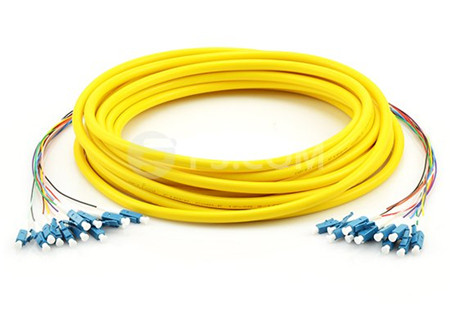
Features:
- Good resistance to environmental effects. Some formulations are rated for -55 to +55.
- Good flame retardant properties. Can be used for both outdoor and indoor fiber optic cables.
- PVC is less flexible than PE (Polyethylene).
PE (Polyethylene)
Polyethylene is a kind of polymer that commonly categorized into one of several major compounds of which the most common include LDPE, LLDPE, HDPE, and Ultrahigh Molecular Weight Polypropylene. Polyethylene fiber has a round cross section and has a smooth surface. Fibers made from low molecular weight polyethylene have a grease like handle.
Features:
- Popular cable jacket material for outdoor fiber cables
- Very good moisture and weather resistance properties
- Very good insulator
- Can be very stiff in colder temperatures
- If treated with proper chemicals, PE can be flame retardant.
Kevlar (Aramid Yarn)
The word Aramid is a generic term for a manufactured fiber in which the fiber forming substance is a long chain synthetic polyamide in which at least 85% of the amide linkages are attached directly to the two aromatic rings as defined by the U.S. federal trade commission. Kevlar fiber is based on poly (P-phenylene terephthalamide). Aramid yarn is the yellow fiber type material found inside cable jacket surrounding the fibers. It can also be used as central strength members.
Features:
- Aramid yarn is very strong and is used in bundle to protect the fibers.
- Kevlar is a brand of aramid yarn. Kevlar is often used as the central strength member on fiber cables which must withstand high pulling tension during installation.
- When Kevlar is placed surrounding the entire cable interior, it provides additional protection for the fibers from the environment.
Steel Armor
The steel armored fiber cable, using light-steel tube, can provide maximum bend radius, strong protection and flexible cabling. Steel armor jacket is often used on direct burial outdoor cables and it provides excellent crush resistance and is truly rodent-proof. Since steel is a conductor, steel armored cables have to be properly grounded and loss fiber optic cable’s dielectric advantage. Armored fiber optic cable are often used in the outdoor direct burial cables and for the industrial environment where cables are installed without conduits or cable tray protection. The following image shows a single-mode armored fiber optic cable.
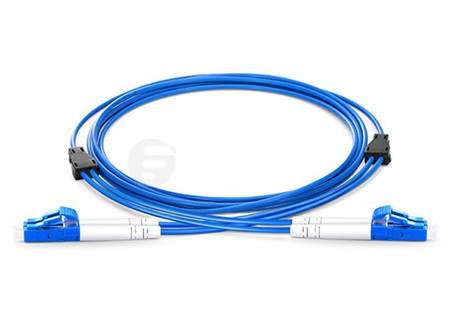
Various types of these light-steel armored fiber cables are in stock in FS.COM, including pre-terminated armored fiber patch cables, armored fiber trunk cables and field-terminated armored fiber cables for both indoor and outdoor applications.
Features:
- Provides excellent crush resistance for outdoor direct burial cables
- Protects cables from rodent biting
- Decreases water ingress into the fiber which prolongs the fiber cable’s life expectancy
Central Strength Member
Strength member is used to increase the tensile force that will be applied on the cable during installation. Strength member will take the pulling force and will keep the fibers safe during installation. For large fiber count cables, a central strength member is often used.
The central strength member provides strength and support to the cable. During fiber optic cable installation, pulling eyes should always be attached to the central strength member and never to the fibers. On fiber splice enclosure and patch panel installations, the cable central strength member should be attached to the strength member anchor on the enclosure or patch panel.
Conclusion
When you choose to use which type of the fiber optic cables, the fiber optic cable construction, along with the mechanical and environment requirements should all be taken into account. All the above materials in the fiber optic cable construction are specifically required to meet the network infrastructure. FS.COM fiber optic cables come in various types with detailed specifications displayed for your convenient. These quality cables are designed with best-in-class performance. For more information about fiber optic cables or patch cords, you can visit fs.com.
Posted by: fernxu123 at
03:09 AM
| No Comments
| Add Comment
Post contains 775 words, total size 8 kb.
October 20, 2016
Per-terminated cabling is a popular type of termination method that has been used by the overall network designers. It provides an plug-and-play solution for links between switches, servers, patch panels, and zone distribution areas in the data center. Compared to the Fusion splicing, pre-terminated cabling is apparently more suitable to meet the high-bandwidth, high-density network needs. An article entitled "Understanding Pre-Terminated Cabling and Network Deployment†offers some detailed information about the pre-terminated cabling and its advantages. This article will go further to talk about the elements of the pre-terminated cabling including the pre-terminated trunk cables, and plug and play cassettes.
Pre-terminated Trunk Cables
Pre-terminated trunking cable assemblies provide an easily installed and cost effective alternative to individual field-terminated channels. There are basically pre-terminated fiber cabling and pre-terminated copper cabling, which will be ntroduced in the following part.
- Pre-terminated MTP/MPO Trunk Cables
Pre-terminated trunk cable usually terminated with MTP/MPO connectors on both ends that provides a quick-to-deploy, scalable solution that improves reliability and reduces installation time and cost. They are capable of supporting multiple users or devices from one point to another while distributing multiple data channels, which is a convenient and economical alternative to running multiple jumpers or fiber cables. Generally 12-fiber MTP/MPO trunk cables and 24-fiber MTP/MPO trunk cables are commonly used separately for 40G applications and 100G applications. The following picture is a 72-fiber female to female MTP trunk cable.
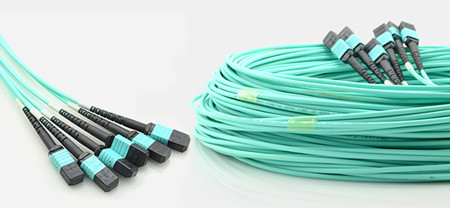
There are also high fiber count MTP/MPO trunk cables which have several legs on both ends. The following picture shows a 72-fiber MTP/MPO trunk cable. There are 6 legs on both ends with each leg terminated with a 12-fiber MTP/MPO connectors.
- Pre-terminated Copper Trunk Cables
Pre-terminated copper cable assemblies including pre-terminated copper trunks and copper patch cords (usually terminated with RJ45 connector), are ideal solutions for data center applications where requires high-efficient deployment. Pre-terminated copper trunk cables are commonly used in point-to-point connections in data centers, such as achieving reliable connectivity between server and switch cabinets. It is a bundle of category cables, built with a choice of 6, 12, or 24 cable bundle and factory terminated with jacks and plugs. The following image shows a jach-to-jack pre-terminated copper trunk cable.
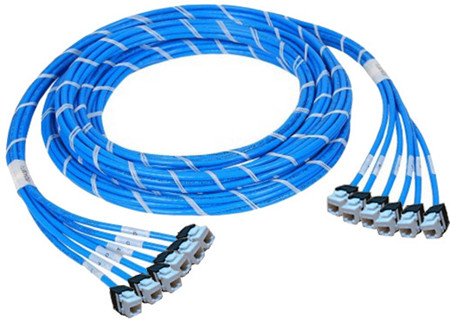
With factory pre-terminated and tested parts, the pre-terminated copper cable assemblies can help users save time and reduce waste. In addition, they allow fast and easy installation with reduced labor costs in large copper infrastructures with high-density cross-connection and patching systems. FS.COM’s pre-terminated copper cable assemblies are pre-bundled and pre-labeled styles, available in Cat 5e, Cat 6 and Cat 6a UTP and STP cable constructions in jack to jack, plug to plug and jack to plug termination ends.
Pre-terminated MTP Cassette—No Work, No Tools, No Mess
MTP cassettes are used to break out the 12-fiber MTP connectors terminated on trunk cables into simplex or duplex-style connectors. Simplex and duplex style jumpers can then be used to patch into transceiver terminal equipment ports, patch panels or client ports. The cassette features simplex or duplex port adapters across the front and one or two MTP connector adapters across the back. A factory-installed and tested optical fiber assembly inside the module connects the front adapters to the back MTP connector adapter. Alignment pins are pre-installed in the MTP connector located inside the cassette. The below image shows the 12-fiber and 24-fiber MTP cassette.
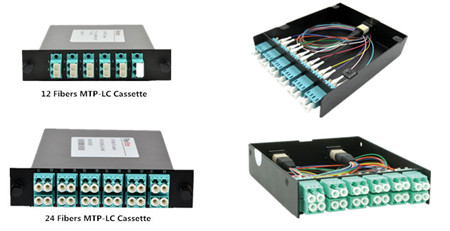
Using MTP cassettes provides adaptability for the changing data center environment. Facing technology refresh frequencies of 12-18 months, Plug & Play MTP cassettes used in the data center offer a great advantage. When connector requirements change in the future, simply swap the cassettes whilst leaving the existing backbone infrastructure intact. 12-fiber MTP to LC and 24-fiber MTP to LC cassettes provide a quick and efficient way to deploy up to 12 LC or 24 LC fiber ports in a single module respectively. MTP to LC cassettes are a quick and efficient way of deploying MTP connector breakout. These cassettes provide significant installation savings with no field terminations required. Simply plug-and-play!
Conclusion
Pre-terminated cabling is the perfect solution to achieve simple and quick installation. Additionally, the transmission testing of pre-terminated cable assemblies is performed by the manufacturer before shipment, and test reports are included with the assemblies. FS.COM offers a full range of high-quality but low-price pre-terminated cable assemblies. Besides that, we also offer Fiber Taps, J-Hook, Fiber Optic Enclosures, Cable Ties, Fiber Optic Wall Plates, etc. And all of them are tested before shipment. If you have any requirement, please send your request to us.
Posted by: fernxu123 at
04:06 AM
| No Comments
| Add Comment
Post contains 755 words, total size 7 kb.
October 18, 2016
With the emerging high-speed network standards and rapidly advancing technology, fiber optic network is driven to meet the growing demand for faster access to larger volumes of data. Although 10G/40G Ethernet becomes the mainstream of telecommunication market nowadays, organizations of all sizes still need to be prepared to integrate speeds of 100G and beyond. For data center networking, users can choose different solutions based on the different transmission distance need. In general, there are two kinds of 100G fiber optic solutions: direct cabling and breakout cabling. It is essential for users to understand the detailed information of each type of solution in order to select the one that meets their current and future connectivity needs.
How 100G Optics Develop
After the IEEE completing the certification of the first 100G standard for Ethernet networks, the transceiver industry launched a new type of form factors for 100G connectivity—CFP ("C" for 100, and FP for Form factor Pluggable). Compared to the most popular 40G QSFP, the size of CFP transceiver is huge. And most CFP implementations doubled the power consumption per bit. Furthermore, the price per bit increased by a factor of ten. These disadvantages becomes the main obstacles of the popularity of 100G CFP transceivers.
The next version of 100G form factors is the CFP2, CFP4, and the CPAK that are improved upon the CFP. But when compared to the popular 10G SFP+ and 40G QSFP+, none of these new members of the CFP family improved density, power consumption, or cost. Fugure 1 shows the size comparison between CFP2, CFP4 and QSFP28 modules.
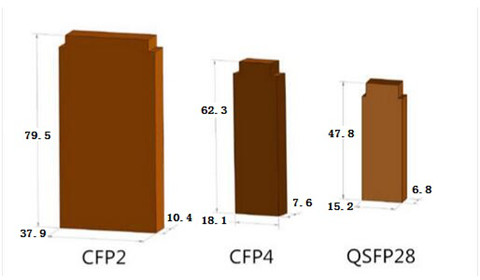
Then here came the 100G QSFP28. The QSFP28 is the exact same footprint as the 40G QSFP+. The 100G QSFP28 is implemented with four 25-Gbps lanes, Just as the 40G QSFP+ is implemented using four 10-Gbps lanes. In all QSFP versions, both the electrical lanes and the optical lanes operate at the same speed, eliminating the costly gearbox found in CFP, CFP2, and the CPAK. The 100G QSFP28 makes it as easy to deploy 100G networks as 10G networks. When compared to any of the other alternatives, 100G QSFP28 increases density and decreases power and price per bit. That’s why it is fast becoming the universal data center form factor. The following part will move on to talk about the 100G optic cabling solutions.
100G Direct Cabling Solutions
QSFP28 transceiver utilizes either fiber or copper media to achieve 100GbE communication in each direction. This transceiver has 4 individual 25GbE lanes which can be used together to achieve 100GbE throughput or separately as 4 individual 25GbE connections (using 4 SFP28 modules).
For 100G short-reach direct cabling within 100m, 100GBASE-SR4 QSFP28 optical module and 100G QSFP28 cable are good choice. Just from the table list of FS.COM 100G optical modules and cables, we know that 100GBASE-SR4 QSFP28 modules can support up to 100 m on OM4 12 fiber multimode MTP cable. And 100G QSFP28 to QSFP28 direct attach copper cable can support up to 5m and 100G QSFP28 to QSFP28 active optical cable can support up to 10m. Figure 2 describes a 100G direct cabling with the use of QSFP28 to QSFP28 DAC and AOC cables.
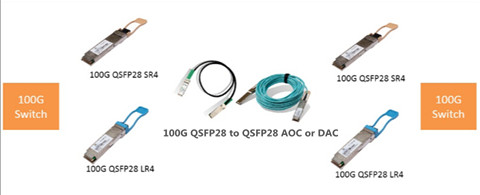
For 100G long-haul direct cabling, like 10km, both 100GBASE-LR4 QSFP28 optical module and 100GBASE-LR4 CFP4 transceiver can support up to 10km on single-mode LC patch cables. For longer 100G direct cabling above 10km, the 100GBASE-ER4 CFP is the ideal choice as their transmission distances support up to 40 km.
100G Breakout Cabling Solutions
A breakout cable is a multi-strand cable, typically custom-made, which is divided into multiple duplex cables. For instance, a 40G breakout cable has four individual 10G duplex cables totaling eight strands, while a 100G breakout cable has 10 duplex cables and 20 strands. Figure 3 displays a simple 100G connectivity with 100GBASE-SR4 QSFP28 and QSFP28 to 4SFP28 breakout cables.
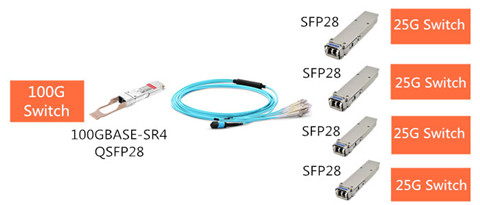
Between the 100G optical module and 25G optical modules, there always uses the breakout cables connected the two kinds of optical modules, and the common cable solutions are 100G QSFP28 to 4SFP28 Breakout AOC cables or 100G QSFP28 to 4x 25G SFP28 Breakout Direct Attach Passive Copper Cables.
The commonly used 100G breakout cabling solutions is 100G QSFP28 to 4SFP28 DAC. It’s easy to understand how this type of cable function. Just as the QSFP+ breakout cable, the 40GBASE-SR4 QSFP+ optical module at the one end can be connected to 4x10GBASE-SR SFP+ optical modules at the other end.
Conclusion
As IT infrastructures are planning to migrate to 100G data rate, network designers must carefully weigh alternative implementations of such links. With a variety of fibers already deployed, it is important to understand the interoperability of new optics with existing fibers. And for 100G deployment, you are supposed to understand the benefits and challenges of each type of the fiber optic solutions before taking an action. FS.COM’s 100G FHD series covers a full range of 100G optical transceivers and cables, like CFP, CFP2, CFP4, QSFP28, as well as 100G QSFP28 to QSFP28 DAC, 100G QSFP28 to 4SFP28 DAC. Besides the above products, 100G FHD Fiber Enclosures, 100G FHD MTP Modular Cassettes, 100G 160 Fiber 2U Panels and 100G CFP SR10 Cables are also provided. If you want to know more about our products, please contact us directly.
Posted by: fernxu123 at
02:52 AM
| No Comments
| Add Comment
Post contains 879 words, total size 7 kb.
October 14, 2016
Due to the server consolidation, virtualization, and performance improvements, data center designers are eager to migrate from 10G to 40G to better meet their network demand. However, there are many 40G optical transceivers and cabling solutions available for sale, such as QSFP-40G-SR4, QSFP-40G-LR4, QFX-QSFP-40G-ESR4, as well as QSFP DAC/AOC cables. So, which one is the most cost-effective solution? No one can give you an exact answer without the detailed information. The above 40G optical transceivers and cables have already been introduced in the previous articles. Today, I am about to shed light on a new QSFP optical transceiver—SMF&MMF 40G QSFP+ (QSFP-40G-UNIV) and its function in 40G migration.
What Is SMF&MMF 40G QSFP+ Transceiver?
The typical fiber optic transceiver may either operate on multimode fiber or single-mode fiber. For example, the Cisco QSFP-40G-SR4, QSFP-40G-LR4 can only operate over multimode fiber for up to 150m, and single-mode fibers with a link length of 10km, respectively. However, a SMF&MMF 40G QSFP+ transceiver as the name implies, can be used with both multimode and single-mode fibers without the need for any software/hardware changes to the transceiver module or any additional hardware in the network. This is usually accomplished (seen in Figure 1) by combining four 10G optical channels at different wavelengths (1270, 1290, 1310, and 1330 nm) inside the transceiver module to transmit and receive an aggregate 40G signal over a single pair of multimode or single-mode fibers.

40GBASE-UNIV and 40GBASE-LX4 QSFP+ Transceiver Overview
Vendors like Huawei, Arista, H3C and Cisco all offer QSFP-40G-UNIV optical transceivers. Based on IEEE 40GBASE-LR4 specifications, QSFP-40G-UNIV operates in the 1310nm band. It uses a duplex LC connector and supports distances up to 150 m over OM3 or OM4 multimode fiber and up to 500 m over single-mode fiber (different vendor may have different specifications). Besides the QSFP-40G-UNIV transceivers, 40GBASE-LX4 QSFP+ transceiver is the other type of the SMF&MMF 40G QSFP+. Take Juniper JNP-QSFP-40G-LX4 as an example, the Juniper 40 Gbps LM4 QSFP+ optical transceiver, part of the Juniper family of optical transceivers, is optimized to fully leverage 40 Gigabit Ethernet (GbE) switches and routers. Figure 2 shows FS.COM SMF&MMF 40G QSFP+ transceiver solutions.
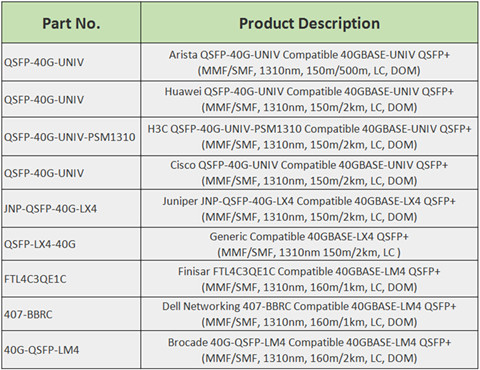
Why Should We Use SMF&MMF 40G QSFP+ Transceiver to Achieve 40G Migration?
With the increase in data center bandwidth requirements, migration to 40G for switch to switch connections is in higher demand. SMF&MMF 40G QSFP+ transceiver is designed to allow for seamless migrations from existing 10G to 40GbE networking without requiring a redesign or expansion of the fiber network. Besides, this transceiver also provides a cost-effective solution to migrate from multimode to single-mode fiber, allows a single-mode fiber infrastructure for distances up to 500m. The following part presents the unique merits of SMF&MMF 40G QSFP+ transceiver.
- Upgrade to 40G Without Additional Cables
The existing QSFP+ transceiver like QSFP+ SR4, QSFP+ CSR4 and QSFP+ LR4 optics, utilizes four independent 10G transmitters and receivers for an aggregate of 8 cables for 40G links. Therefore, customers have to add additional fiber to increase the number of 40G links. However, a SMF&MMF QSFP+ uses duplex LC connector that is consistent with the existing 10G connections, which are also commonly MMF cables with duplex LC connectors. Therefore, a SMF&MMF QSFP+ allows the same cables to be used for direct 10G connections to direct 40G connections, resulting in zero-cost cabling migration. What’s more, by deploying the SMF&MMF 40G QSFP+ transceiver, customers increase the number of 40G links by 4 times without making any changes to their fiber infrastructure, which greatly expand network scale and performance. Figure 3 shows the difference between QSFP+ SR4 QSFP+ and 40GBASE-UNIV universal modules.
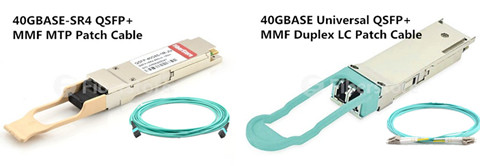
- Realize the Migration From Multimode to Single-mode Fiber
There is a increasing trend for data center designers to move to single-mode optical solutions due to the distance limitations of the multimode cabling system. When data rates increase from 40G to 100G and beyond to 400G, it is just not that easy to move to single-mode cable system for cost effectiveness. Because network managers needs to replace all the old multimode optical devices into brand new single-mode equipment, which usually costs a large mount of money. However, with SMF&MMF QSFP+ optic module, migrating to 40G and 100G will be simpler. As SMF&MMF QSFP+ interoperates with 10km QSFP-LR4 optics, it s a cost effective solution for SM fiber infrastructure for distances up to 500 m.
- Simplify the 40G Cabling System
The SMF&MMF 40G QSFP+ transceiver offers the unique advantage of operating on both multimode and single-mode fiber without any requirement for additional hardware or software. Customers can consolidate their optics and use SMF&MMF QSFP + in their network irrespective of the fiber type, which makes full use of the existing cabling systems, reduces the cost of deployment and of support, and simplify purchasing and deployments.
Conclusion
SMF&MMF 40G QSFP+ transceiver offers a cost-effective transition path for migrations to single-mode fiber in data centers with a single transceiver that bridges the gap between multimode and single-mode optics, enabling data centers running at 10G today to seamlessly upgrade to 40G without having to re-design or modify the cable infrastructure. FS.COM offers a full range of 40G optical transceivers and cables that ensure the smooth migration to 40G data center deployments. Products like QSFP-40G-SR4, QSFP-40G-LR4, QFX-QSFP-40G-ESR4, as well as QSFP DAC/AOC cables are well-tested and fully compatible with major brand. The SMF&MMF 40G QSFP+ transceivers are also offered with very competitive price but high quality. Contact us if you are interested.
Posted by: fernxu123 at
06:35 AM
| No Comments
| Add Comment
Post contains 912 words, total size 8 kb.
October 13, 2016
Without denying that the market for 100G data center optics is accelerating, and more and more telecommunication vendors are aiming to seize this opportunity to launch cost-effective 100G solutions. FS.COM also offers a series of 100G optical modules and cabling solutions that are compliant to the IEEE standards. Our 100G optical modules support different transmission distance from 100m, 10km and more reach options in CFP and QSFP28 form factors. Before introducing the FS.COM 100G optical modules, let’s firstly talk about the 100 Gigabit Ethernet standard.
IEEE 100GbE Standard Introduction
Defined by the IEEE 802.3ba-2010 standard, 100 Gigabit Ethernet (100GbE) technology was given birth to transmit Ethernet frames at the rates of 100 gigabits per second. The 100G optical modules are not standardized by any official standards body but are in multi-source agreements (MSAs). The major 100Gigabit Ethernet 100GBASE-R optical module standards are briefly listed in the below table.
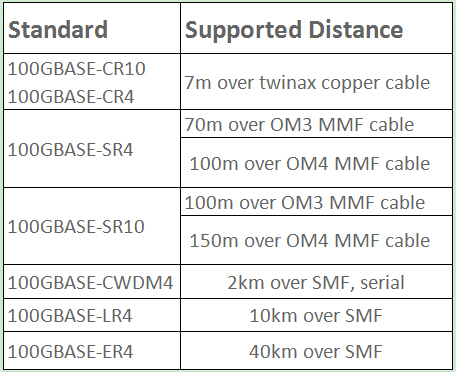
According to the above table, the 100GBASE-CR4 and 100GBASE-CR10 standards were met by twinax copper cable with a link length of 7m. The 802.3bm standard was approved in 2015, which specifies a lower-cost optical 100GBASE-SR4 PHY for multimode fibers (MMF). The 100GBASE-SR4 standard can operate over OM3 MMF for a link length of 70m, and transmit over OM4 for a link length of 100m. QSFP28-100G-SR4 is one of the common types of the 100G modules, which can be used in 100 Gigabit Ethernet links on up to 100m of OM4 multimode fiber.
For those infrastructure who require a link length longer than 2 km, 100GBASE-LR4 and 100GBASE-ER4 standards were introduced. These two standards are specially designed for use in long haul applications. For example, QSFP28 100GBASE-LR4 optics can support a distance of 10km, and the CFP 100GBASE-ER4 operate over single-mode fiber for a distance of 40km.
As for the 100GBASE-SR10 or 100GBASE-CR10, the 10x10 MSA was intended as a lower cost alternative to 100GBASE-SR4 for applications, which defines an optical Physical Medium Dependent (PMD) sublayer and establish compatible sources of low-cost, low-power, pluggable optical transceivers based on 10 optical lanes at 10 Gbit/s each.
FS.COM 100G Optical Modules
FS.COM provides 100G QSFP28 optical modules, including 100G QSFP28 SR4, 100G QSFP28 LR4 as well as 100G CFP LR4 optical module. All these 100G transceivers are good choice for today’s high-density data center 100G interconnection and networking.
- QSFP28 100GBASE-SR4
The QSFP28 100GBASE-SR4 transceiver, based on the QSFP28 from factors, is a parallel 100G optical module designed with optical/electrical connection and digital diagnostic interface. It offers 4 independent transmit and receive channels, each capable of 25Gbps operation for an aggregated data rate of 100Gbps for 100 m on 12-fiber MPO/MTP OM4 multimode fiber.
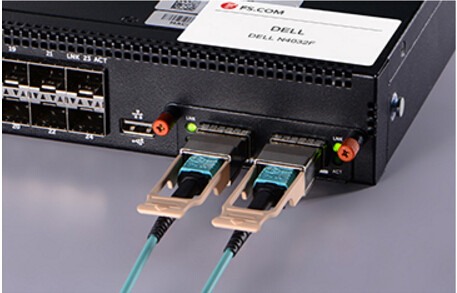
The QSFP28 SR4 module is a vertically integrated solution that meets IEEE 802.3 standards and MSA requirements with power dissipation well under 3.5W. It supports both 100GBASE-SR4 as well as 4x25G breakout applications, 100G QSFP28 to QSFP28 DAC and 100G QSFP28 SR4 to 4x25G SFP28 break-out cables, meeting the harshest external operating conditions including temperature, humidity and EMI interference.
- QSFP28 100GBASE-LR4
The 100GBASE-LR4 QSFP28 transceiver, compliant to 100GBASE-LR4 of the IEEE P802.3ba standard, is also a 100Gbps transceiver module designed for long-reach communication applications. This module converts 4 input channels of 25Gbps electrical data to 4 channels of LAN WDM optical signals and then multiplexes them into a single channel for 100Gbps optical transmission. The high performance cooled LAN WDM EA-DFB transmitters and high sensitivity PIN receivers provide superior performance for 100GbE applications up to 10km links over single-mode fibers.
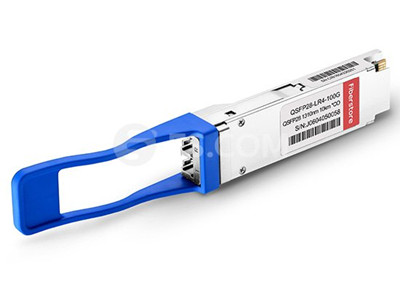
Conclusion
According to the market researchers, the 100G optical transceivers market will be booming in the near future. So what are you waiting for? It is the ideal time for data center designers to prepare for the data center networking and architecture beforehand with 100G transceivers and cables. Contact us for the available 100G optical modules: 100G QSFP28 SR4, 100G QSFP28 LR4, 100G CFP, CFP2 and 100G CFP4 optics. Besides 100G optical modules, FS.COM also provides 100G cable solutions like 100G active optical cable (AOC) and 100G direct attach cable (DAC). You can have what you need here.
Posted by: fernxu123 at
03:16 AM
| No Comments
| Add Comment
Post contains 683 words, total size 6 kb.
October 11, 2016
The present 10G network infrastructure has absolutely no more capacity from which we can grow. They just need to scale it up by using 40-Gigabit Ethernet QSFP+ equipped devices and with further scalability options in the near future. But most people may run into an awkward situation that they are out of money to upgrade all of the 10G hardware. Thus owing to the price perspective, some users still stay at 10G Ethernet network. QSFP+ to SFP+ cables or QSFP+ to 4SFP+ fanout cables are introduced to offer a highly cost-effective way to establish a 40G links, which is sure to be a great news to them. QSFP+ to SFP+ direct attached cables (DAC), as an essential component to support 40G connectivity, will be introduced in this passage.
QSFP+ Cables
Despite the fact that there are several QSFP+ cables available for sale, the optical QSFP+ DAC cables are sure to be the best of them. In general, QSFP+ DAC cables are marked as the most cost-effective cables used inside a short distance for 40G data center connectivity. This cables are exceptionally flexible and utilize the QSFP+ connector to compose the most of signal’s potency.
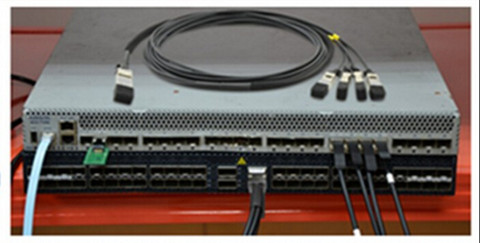
Compared with the fiber optic cables, this cable features firmness and thickness, which make up its sturdiness and reliability. The QSFP+ to SFP+ cables are supposed to be factory terminated in order to meet up the discrete specifications so that it can be ordered to the length. Another feature of the cable which makes it idiosyncratic is its robustness. The cables are made up of leading edge technology and try to allow you to cherish your internet for long hours. There are basically two types of QSFP+ DAC cables: QSFP+ to QSFP+ cables, QSFP+ to SFP+ cables. The following part will continue to talk about the QSFP+ to SFP+ cables.
QSFP+ to SFP+ Cables
QSFP+ to SFP+ cables connect a single 40G QSFP+ port of a QSFP+ switch on one end and four SFP+ ports of s SFP+ on the other end, allowing users to connect multiple ports of SFP+ equipment to QSFP+ based equipment with a single, easy-to-manage assembly just as seen in the below image. The QSFP+ to SFP+ hybrid assembly's four hot-pluggable SFP+ connectors are factory-terminated to twinaxial shielded cable to provide superior signal integrity in support higher frequency data rates. The assemblies are impedance matched to ensure interoperability with SFP+ host ports and minimize insertion loss.
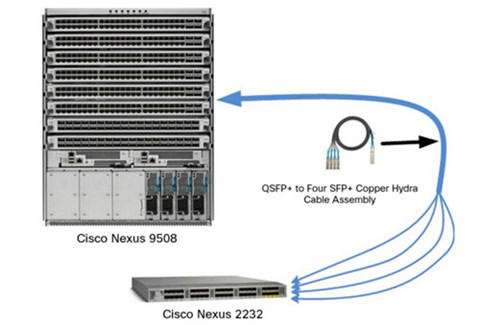
The four 10G SFP+ connectors feed into a single 40Gb/s capable QSFP+ connector. The 4-lane QSFP+ form factor interface supports up to 10Gb/s per lane, providing 40G data transfer rates. In terms of both physical connector space and data throughput, a single QSFP+ connector can replace up to four standard SFP+ connections, providing greater port density and reduced system cost.
Designed for link lengths up to 5 m, these low-power interconnects are compatible with a wide array of data protocols, including InfiniBand 4X SDR, DDR, QDR as well as Ethernet 10G, 40G (IEEE-802.3ba) and SONET electrical failover 40G links. They also support Fibre Channel SAN 10G, 40G and SAN; RapidIO and Myrinet 40G systems links.
Summary
Maybe it is the ideal time for you to cost-effectively upgrade from your older, slower 10G networks to the newer, faster 40G optical network by using the 40G copper cables. QSFP+ DAC cables, especially the QSFP+ to SFP+ cables, will be sure to offer you a remarkable and hassle free experience. If you have made up your mind to embrace a brand new internet speed, FS.COM’s QSFP+ and SFP+ interconnects is automated, and walk through the testing challenges and 100% compatibility.
Our QSFP+ to SFP+ hybrid cable assemblies were developed as a cost-effective means of integrating higher performance QSFP+ equipment with current SFP+ systems in high-performance computing, enterprise networking, video networking and network storage applications. Each end of the hybrid assembly is compliant to the SFF specifications that define the mechanical and electrical requirements for interoperability. If you have any requirement of our products, please send your request to us.
Posted by: fernxu123 at
02:55 AM
| No Comments
| Add Comment
Post contains 676 words, total size 5 kb.
34 queries taking 0.123 seconds, 90 records returned.
Powered by Minx 1.1.6c-pink.









